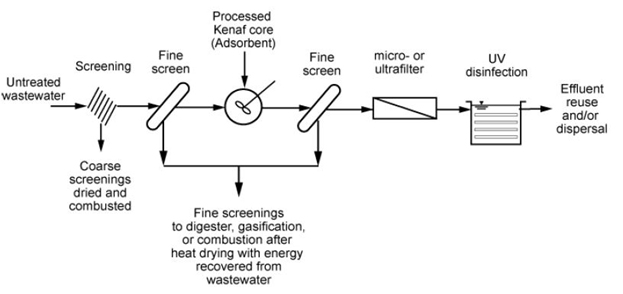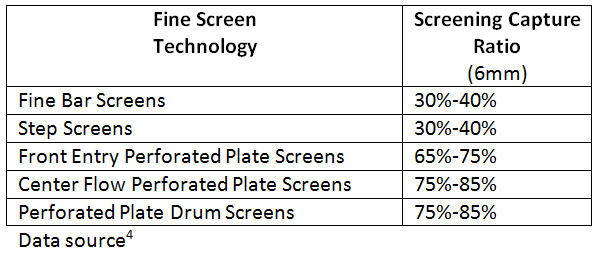WWEMA Window: Slots vs. Holes In Preliminary Treatment Screening
By Tammy Bernier, president and CEO of Duperon Corporation
The impact of preliminary treatment (i.e., grit removal, screening, washing compacting of screenings, handling of screenings, and resource recovery) on downstream processes is becoming more apparent as the industry looks for ways to reduce operating costs and increase process results. Some operators suggest that as much as a 10-fold process savings can be realized by increased preliminary treatment.
Dr. George Tchobanoglus, Professor Emeritus, Civil and Environmental Engineering, University of California, Davis — a thought leader on the wastewater treatment plants of the future — predicts a trend toward more thorough preliminary treatment with a focus on screening and filtration. In one model of what a treatment plant of the future might look like, Dr. T (as he is often referred) suggests that the biological processes will be dramatically reduced or even eliminated in favor of filtration and disinfection (see Figure 1).

Figure 1: Concept model of the treatment plant of the future, as suggested by Dr. George Tchobanoglus (this is just one of several concept models developed by Dr. T.)
Given this increased attention to preliminary treatment and screens in particular, this article will focus on the application basics of screen types (i.e, slotted screens versus screens made up of holes).
Several options for screening of plant influent are currently available in the United States: bar screens, traveling band screens, step screens, front-entry perforated plate screens, center-flow perforated plate screens, and perforated plate drum screens.
One of the basic characteristics that differentiate various screening technologies is the geometry of the aperture of the screen opening. This differentiation can be simplified into two screen aperture types: slots and holes.

Slots vs. Holes
Screen types that employ apertures with a slot-like geometry are bar screens and step screens. Screen types that employ apertures with a hole-like geometry are front-entry perforated plate screens, center-flow perforated plate screens and perforated plate drum screens.
The most common slotted-type screens are bar screens. Step screens also have a slotted-type aperture, but are less common. All perforated plate screens are hole-type screens.
In making the basic choice of whether to choose a screen with a slotted-type aperture or a screen with a hole-type aperture there are several considerations.
Process Considerations
Plant Operations:
Reviewing the flow, hydraulics, influent debris (pumped/gravity fed, ranges of size and volume) and the available room for equipment may be the first considerations of what screening is appropriate. It will also determine if graduated screening is required (coarse to fine).
Next, is the type of plant. Those with IFAS, membrane filters, etc. can become fouled if the effluent is not minimized for debris such as fine filters or hair.
And finally, the operational impacts of increased screenings due to increased capture should be weighed and considered as well. Assuring that there is the space, manpower, or automation to remove debris. Cost/benefit analysis of the additional operational and landfill costs should be weighed against the decreased maintenance of downstream equipment and reduced treatment costs of the effluent.
Selecting the Screen:
The first consideration has to be the potential impacts of the screen effluent on downstream processes and the second has to be the characteristics of the influent debris. Debris that has square-like aspect ratio can easily be screened by either type screen — slot or hole. However, if it is important that debris with an aspect ratio that is extended in one direction (i.e., hair, string, etc.) be absolutely removed, then the choice will have to be a screen type with a hole-type aperture.
Slot-type screens are considered to be one dimensional, meaning that they will pass debris when any one of its dimensions are smaller than the aperture (think narrow width for the opening size and really long height—potentially the length of the screen).
In comparison, hole-type screens are considered to be two dimensional in that debris must be within the size of the aperture in at least two dimensions (though rare, the two dimensionality does not preclude the remote possibility of a hole-type screen passing of a perfectly aligned long cylindrical object that is within the aperture dimensions).
Downstream treatment requirements will impact the choice of both aperture and size of the screen openings. Hole-type screens are essential to the prescreening of debris ahead of membrane-based processes because of their two dimensional screening ability. However, hole-type screening is typically more costly than slot-type screening in both capital and operating costs. For example: mechanical self-cleaning bar screens are quite simple compared to the infrastructure required for a perforated drum screen, with its additional pumps and piping. Operationally, most perforated plate screens require complex cleaning systems which employ wash water, increased horse power and employ many more moving parts. Also, many perforated plate screens rely on the use of dynamic seals which will ultimately wear and leak, requiring shut-down and replacement.
Pre-screening (or graduated screening) may be needed ahead of hole-type screens as they are generally less robust than slot-type screens. In retrofit situations, pre-screening and the space required for pre-screening elements may impact channel hydraulics.
Capture Considerations
The big advantage of hole-type screens over slot-type screens is the high capture rates possible with hole-type screens, sometimes as much as 30 percent better capture (in percentage of capture). Depending on downstream processes this difference can be critical — think membrane-based systems. This level of capture is much less critical for biologically-based downstream processes — though improved capture has been shown to improve most downstream process, assuming organic matter is passed downstream in sufficient quantity to support biological processes (see Charts 1, 2, and 3).
Chart 1: Note: Screen Capture Ratio (SCR) is a measure of the quantity of screenings removed by the screen relative to the total amount in the raw wastewater.

Chart 2: Capture differences are more apparent as the target debris size is reduced. As the screen opening decreases, its capture efficiency for the gross materials increases, resulting in significant accumulations of fecal matter and other organics. For this reason, the organics-laden screenings need further processing before disposal.

Chart 3: The volume differences in captured screens is less pronounced when comparing gross volume as compared to percentage of screenings.

Headloss Considerations
The channel must be reviewed for its hydraulic profile, especially in retrofit applications if moving from coarse to fine screening. (For example: a change in preliminary screening size or type for an existing facility may require changes to the channel configuration to meet regulatory headloss requirements.)
When comparing slot-type screens and hole-type screens, there are different impacts on headloss of each type screen. The headloss versus flow rate performance of a screen is predominantly a function of the open area of the screen and the ability to clean the screen and prevent blinding (note: certain sites require de-ration due to site, channel and/or debris conditions).
Slot-type screens are generally simpler and easier to keep clean mechanically and have lower and more consistent headloss than hole-type screens. This is because hole-type screens have increased capture (as discussed above) and are more difficult to effectively clean, which can result in wide variations in headloss and a greater potential for stapling or blinding.
Other Considerations
Beyond the basic considerations of slot or hole, it must be considered that significant design variances exist between different manufacturers’ screens and the performance is a function of screen configuration, flow patterns, opening configuration, and opening size.
We know from experience that each preliminary treatment application is unique and requires thorough analysis beyond the simple principles discussed within the scope of this article. However, it is clear that improved and more extensive preliminary treatment holds one of the keys to the improved performance, more effective processes, improved effluent and reuse water, reduced energy costs, and lower overall life-cycle costs in the treatment plant of the future.
References:
- Dr. George Tchobanoglus, The Evolution of Wastewater Treatment (Presentation: H2O New York City Water Summit, New York, NY April 9, 2010). www.columbia.edu/~kc2288/Tchobanoglous.pdf
- Dr. George Tchobanoglus, (Presentation: Bochardt Conference, Michigan State University, East Lansing, MI, March 3, 2014) www.youtube.com/watch?v=7ie6SKoZ8No
- Claudio Ternieden, Future Technologies for Sustainable Wastewater Treatment (Presentation: Blue Tech Innovation Forum, Water Environment Research Foundation, June 8, 2010) www.bluetechforum.com/wp-content/uploads/2011/03/WERF-Future-Technology-for-Sustainable-WWT-6-8-10.pdf?phpMyAdmin=JSIx1kCQ2mkCUcB6jINfvZ7pM59
- UK Water Industry Research Limited, Inlet Screen Evaluation, Year 3 Comparative Report
- Gary Hunter and Tom Cummings, Influent Screening: No Longer a Routine Process with MBRs (Florida Water Resources Journal, January 2008). www.fwrj.com/techarticles/0108%20Tech%20article%203.pdf
- K.-H. Wang and Ziping Dai, Screen Capture Rate Tests, (Department of Civil and Environmental Engineering, University of Houston, Houston, TX). www2.egr.uh.edu/~civeb1/.../03.../13.pdf
